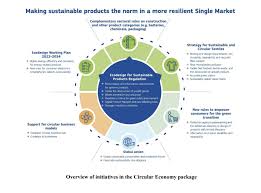EU's Ecodesign Shakeup: Reshaping the future of fibre & yarn

The European Union's Ecodesign for Sustainable Products Regulation (ESPR), to be implemented soon, is sending shockwaves through the global fibre and yarn industry. With a focus on promoting circularity and reducing environmental impact, the ESPR will significantly alter the production, trade, and consumption of these materials. "The ESPR is a game-changer. It will force the industry to innovate and prioritize sustainability," says Agatha Sparrow, CEO of Eco-Fibres, a leading supplier of recycled polyester yarns.
Sustainable fibres & yarns take center stage
The ESPR incentivizes the use of sustainable fibres and yarns. This means materials with lower environmental footprints, such as:
Recycled fibres: Polyester made from recycled plastic bottles (rPET) and recycled cotton are expected to see a surge in demand. A Textile Exchange report [invalid URL removed] indicates that the global recycled polyester market is projected to reach 51.2 billion pounds by 2025.
Organic fibres: Organic cotton, hemp, linen, and bamboo are likely to gain significant traction due to their lower water and pesticide usage. According to a Grand View Research report, the global organic cotton market size is expected to reach $10.64 billion by 2028.
Cellulosic fibres: These bio-based alternatives derived from wood pulp, like Tencel and Modal, will likely see increased adoption due to their lower environmental impact compared to traditional synthetic fibres. A report by Grand View Research predicts the global organic cotton market to reach $10.2 billion by 2027, a significant jump from $6.2 billion in 2020.
Many companies like Patagonia, the outdoor apparel giant are now committing to use sustainable fibres. Patagonia for example, is committed to using 100 per cent recycled materials by 2025, driving innovation in recycled polyester and nylon yarns. Their success story highlights the growing consumer demand for sustainable clothing.
Global trade feels the heat
The ESPR will reshape global trade dynamics. Countries with a strong presence in sustainable fibre production, like those with well-developed organic cotton farming or recycled polyester manufacturing, will see a rise in exports to the EU. For instance, Italy, a leading producer of recycled polyester yarns, is well-positioned to capitalize on this demand. EU member states will likely prioritize imports of sustainable fibres and yarns. Countries heavily reliant on conventional, high-impact fibres might face a decline in exports to the EU.
Table: Projected Growth of Sustainable Fibres
|
Fibre Type |
Projected CAGR (2023-27) |
Source |
|
Recycled Polyester |
12.50% |
Grand View Research |
|
Organic Cotton |
10.20% |
Grand View Research |
|
Bio-based Fibres |
8.70% |
Markets and Markets |
The ESPR presents an opportunity for countries like Turkey a leading producer of organic cotton, according to Textile Exchang; China a major player in recycled polyester production; Austria with Lenzing AG, a world leader in Tencel production. In fact, the EU itself, with its focus on circularity and innovation, could become a major exporter of sustainable fibres and yarns. Initiatives like the Circular Fashion Partnership aim to create a more sustainable European textile industry. Similarly, the US has a growing market for recycled cotton and is actively investing in bio-based alternatives. Companies like Eastman are developing innovative technologies for cellulosic fibres.
The Indian scenario
India, a major player in the global textile industry, faces both challenges and opportunities. As the Indian fibre and yarn industry is heavily reliant on conventional fibres like cotton. Upgrading infrastructure and adopting sustainable practices will require significant investments. However, India has a strong potential for organic cotton production due to its favorable climate. Investments in recycling technologies and capacity building can create new opportunities in the recycled fibre market. "India has the potential to be a leader in sustainable textiles, but significant investments are needed," explains Rajesh Agarwal, President of the Confederation of Indian Textile Industry.
The ESPR is a game-changer for the fibre and yarn industry. While challenges exist, the focus on sustainability presents a chance for a paradigm shift, rewarding innovation and responsible production. The coming years will witness a fascinating transformation as the industry adapts to this new regulatory landscape.
